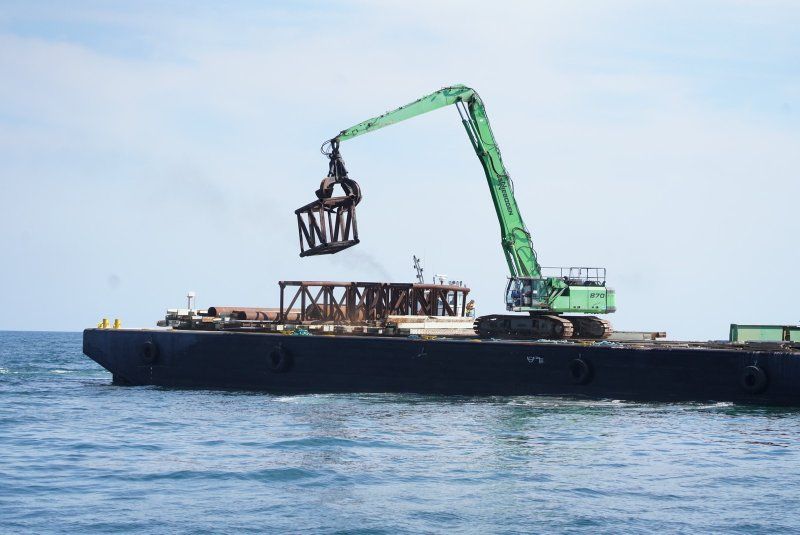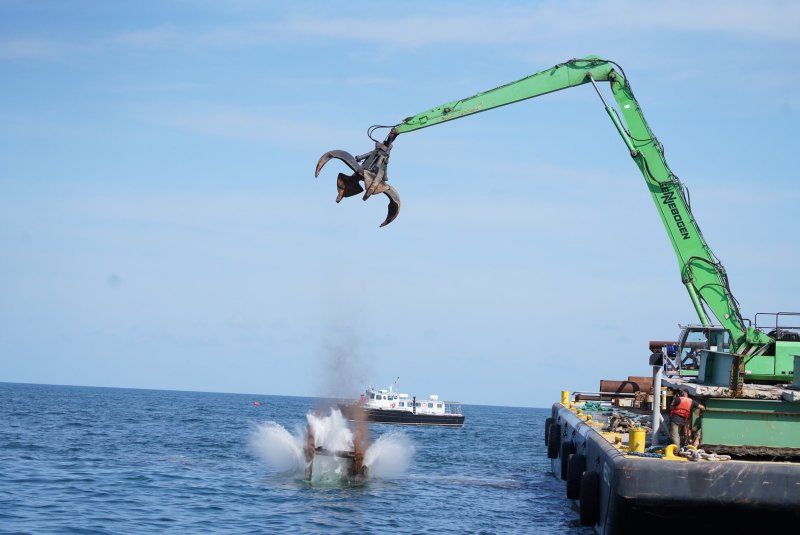A Salvaged Banksy Mural is Now on View in NYC
This unique Banksy mural goes up for auction on May 21st in NYC!


In 2017, we watched as the Kosciuszco Bridge between Queens and Brooklyn was demolished, barged down the East River in sections, and made it to New Jersey where it was being prepared for recycling. Now, we can report were the former bridge ended up: under the waters of the Atlantic Ocean.
As part of an ongoing initiative to develop a stronger, more diverse marine ecosystem in New York, Governor Cuomo launched the second year of the largest artificial reef expansion in New York State history this past weekend. To create the new marine habitat, the Governor deployed recycled materials at Fire Island Reef from the Staten Island Expressway, Kew Gardens and Kosciuszco bridges, vessels from the Erie Canal and the retired U.S. Army Corps of Engineers steel vessel M/V HUDSON. This ongoing expansion hopes to encourage Long Island‘s recreational and sport fishing and diving industries.
“New York State is doing more than any state in the United States when it comes to climate change and protecting the environment,” Governor Cuomo said. “Reefs are great for the environment and the economy, and the new reefs created under our comprehensive artificial reef program are already incredibly successful.”

Photo by Office of Governor Andrew M. Cuomo
This deployment contributes to Governor Cuomo’s Artificial Reef Initiative, New York’s first ever comprehensive program to construct artificial reefs, announced in April of 2018. The unprecedented effort is deploying large amounts of recycled materials cleaned of contaminants from the State Department of Transportation, the New York State Thruway Authority and other partners. Over time, these recycled structures will create a habitat similar to a natural reef. This is a similar process to the repurposing of New York City subway cars as artificial reefs along the Eastern seaboard, a 10-year program by the MTA that has since concluded.

Photo by Office of Governor Andrew M. Cuomo
New York State currently has twelve artificial reefs, which are managed by the New York State Department of Environmental Conservation’s (DEC) artificial reef program. Two reefs are off Long Island, two in the Great South Bay and eight in the Atlantic Ocean. The DEC also deployed a pier, bridge support concrete and concrete barriers from the decommissioned Mill Basin Drawbridge to Hempstead reef in January and February 2019.

Photo by Office of Governor Andrew M. Cuomo
In 2018, materials were deployed to the Hempstead, Moriches, Rockaway, Shinnecock, Smithtown, and Fire Island artificial reefs, including parts of the old Tappan Zee Bridge, Erie Canal barges, turbines from the New York Power authority, steel pipes and trusses from the New York State Department of Transportation. Marine biologists have documented a rapid colonization of life in those locations under the Artificial Reef Initiative last year, including sponges, mussels, bryozoans, barnacles, anemones of deployed material and reef-associated fish. To better understand reefs and their environmental benefits, Professor Brad Peterson of State University of Stony Brook Southampton is continuing underwater growth research on the newly developed reef material on Shinnecock Reef.
Construction of New York’s first artificial reef dates back to 1949 on McAllister Grounds. This latest initiative marks the State’s first coordinated effort to stimulate the full environmental and economic benefits of artificial reefs. Fire Island is also the location of a real-life shipwreck — the remains of the Bessie White, a schooner, wrecked in 1922 off Smith’s Point and its likely remains were revealed during Hurricane Sandy.
“We are going to continue this success by bolstering the Fire Island reef with an assortment of material, and show that New York, and Long Island in particular, can and will be the showcase to demonstrate how to build a green economy and a green environment for the rest of the nation,” said Governor Cuomo.
Next, check out Inside the New Shirley Chisholm State Park in Brooklyn Along Jamaica Bay and 15 New NYC Public Art Installations Not to Miss in August 2019.
Subscribe to our newsletter